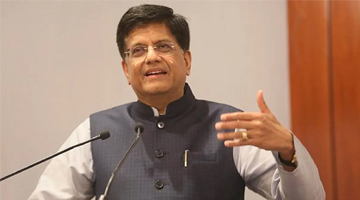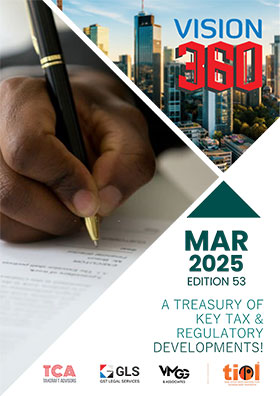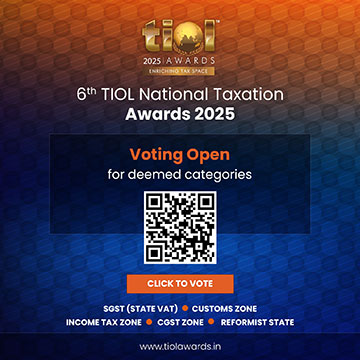GST Council needs to focus more on structural flaws rather than 'scalpelling'!
TIOL - COB( WEB) - 966
APRIL 03, 2025
By Shailendra Kumar, Founder Editor
THE 'taxcade' of GST is plodding towards another milestone - will soon be turning eight. But industry leaders and professionals have begun venting their spleen at its comically inefficient implementation, putatively sowing uncertainty in the tax system! They feel that some sort of dark energy has taken it in its grip, and that is why its advance ruling apparatus has become rutty and goose-pimpling. The embattled GST Appellate Tribunal appears to be bemusingly grappling with birth pangs in its 'foetus' itself. Though the government has appointed its President but other trappings of an operational machine looks stuck at an embryonic stage itself. Against the silhouette of these chilling issues, the moderator of the fifth technical session at TIOL Congress in Mumbai, titled "GST Road Ahead", Shri Pratik Jain, Partner, PwC, volleyed his first salvo at the Senior Advocate, Shri Rohan Shah: How to untangle these snafus and reduce GST litigation turning into 'woolly mammoth'? What could be the legislative tool-kits to diminish the rising legal fisticuffs?
Taking a deep dive into the cobwebs of complex ground realities, Shri Shah commented that when one litigates on the indirect tax side, the gnarliest problem is that by nature, indirect tax is something which businesses cannot pass on or toss aside. The moment a liability is spawned, businesses are left with no option of transferring the burden of tax to anyone, he observed, while stating that such a burden is augmented by interest and penalty. He annotated the idea - one rupee of tax difference ends up engendering a liability worth Rs 2.2, which is a dead cost to the business. So, in indirect tax litigation, he elaborated, one cannot have the luxury of disputes having a life-cycle of more than six months. There is an unavoidable need to ensure that the final decision in every dispute is hammered out within six months! Secondly, every divergence of opinion should not metamorphose into a legal battle unlike the prevailing reality. He further said that incidentally, if such a divergence of opinion is of a value greater than Rs two crores, litigation does not pause before knocking at the door the Apex Court. And the life-cycle of such litigation lies anywhere between 12-18 years before the curtain is brought down over it.
He further opined that the Government needs to legislatively ensure that every rupee of tax paid becomes either credit or refund. The indirect tax system, which stands on the pillar of credit, cannot have a situation where your rupee of tax does not translate into either credit or refund. About 70% of litigation would go extinct if there is clarity on this issue, he added. Shri Shah further observed that legislatively, the country needs to make a distinction between interpretation, litigation and fraud litigation. If there is an interpretational litigation, be it the tax rate or value, it needs to switch to a separate track and the legislation should provide that such litigation would not attract interest and penalty. For fraud cases, he said that one can have higher interest and punitive provisions. However, today's scenario is that every case has an interest and penalty clause, which is unthinkable in the world of indirect taxation!
Shri Shah further remarked that given the current load of cases, higher courts and even Tribunal, cannot handle the back-breaking mounds of fresh cases. Ergo, there is a need to look for a silver bullet outside the courts, he added. Since the advance ruling machine is not working well in the present shape, what may be done is to bring back retired judges, Tribunal members and former Chief Commissioners to man a special advance ruling tribunal - one bench dedicated to classification issues and another for valuation. If time-slots are earmarked for arguments and a deadline of 12 weeks is given for final decision, it may work in favour of the economy. He further added that if AI is used and all key issues are clustered and decided by the benches, about 68% of litigation may boil down to 'ashes' in 12 weeks' time, and at this pace, the GST would become non-litigious tax system in five years.
Reacting to his suggestion, Shri Pratik Jain commented that though it may sound utopian to give final orders in six months but yes, AI can be used to club cases with eight years backlog when the GST Tribunal goes operational. With pleadings only in writing and limited hours' arguments without adjournment, the backlog may be realistically cleared. He then turned to Shri Prashant Bhatnagar, an indirect tax expert, for his experience. He shared the views of global corporate leaders who are often of the view that there is no clarity in the Indian tax system, which has inherent bias for litigation. And a good example is the anti-profiteering authority - quicker decisions could have sorted out disputes much sooner as over 60% cases were quite identical in bones across the industry. Coming out with his experience, the next speaker, Shri Pramod Jain, Chief Taxation Officer of Flipkart, said that ITC, which is interest-free money, often gets stuck with the department forever. Then, there are instances where ITC is still blocked, he added. A time has come to explore the option of a new system like the income tax where you get your refund at the end of the year - once assessments are done, refund is credited automatically rather than credit remaining piled up in the ledger, he remarked. He took the view that if higher quantum of revenue is needed, let the tax rate be higher but it is not fair to neuter credit on genuine business expenses like cab service and staff welfare. In fact, it mirrors intrinsic paradox within the GST law, he quipped.
The next speaker, Shri Hiral Raja, Associate Vice-President of Asian Paints, observed that there were legions of credit-related disputes during the service tax regime but they are not followed today under the GST law. Secondly, blocked credit scheme is immensely hurting the industry as it wallops the value chain and leads to litigation. Another interesting case is that of GST on long-term lease. After the Gujarat High Court decision which rules that no such levy can be imposed, lots of refund claims are stuck. Though the GST Council has approved such a levy but the Council should avoid such litigious decisions. He further quipped that if an issue is decided by the court, the Council should take a decision with retro effect and refunds should be expedited. On his part, Shri Sunil Kothare, Senior Counsel of HDFC Ltd, said that the GST was introduced with economy-wide consultations but, over the years, the scale of dialogue has shrivelled. This is not to say that the industry is not getting fair hearing from the CBIC but what appears to be a missing link is - what is represented to the CBIC and what reaches the Council and whether the Council really considers these representations, that remains a mystery. He further elaborated that though there is an element of trust in the taxpayers at the senior-level but in the field, officers have been trained to suspect that the taxpayers have a lot to conceal from the Revenue. They are oblivious about the fact that there can be a different view on a particular issue and if yes, the same can be escalated to senior-level and a fair decision can be taken
Joining the conversation, Shri Bhatnagar remarked that at some point of time in the past, a taxpayer used to spend 40% of its time on compliance; 40% on litigation and the rest on other related matters. After GST, the time spent on compliance has halved but litigation continues to consume about 30% of time. The fact that the global standard for compliance is about 10-15% and our neighbours which have huge investments from MNCs, have achieved almost zero. Secondly, organised and unorganised sectors taxpayers need to be treated differently for assessments and audits, he expressed his wish list. Disagreeing with him, Shri Rohan Shah said that the core agenda should be the certainty in tax payments. Then, on the issue of organised and unorganised sectors taxpayers, the ideal thing to do is to apply 80:20 principle to tax - If 80% of revenue comes from 20K entities and 20% from two crores, it calls for a different mechanism for risk audit.
On the use of technology in taxation in India, Shri Pramod Jain said that when he tells his counterparts in Walmart, USA, that everything is online in India, they are surprised that India has transformed whereas they still keep everything on paper. IMS system is a big tech leap in tracking all the invoices and credit notes. So, he admitted that compliance is no longer a pain point in India. Technologically, the Revenue is moving fast and the businesses need to catch up sooner. Backing his experience, Shri Raja said that having seen the VAT regime, he is very satisfied with the kind of automation the Government has done for the entire compliance canvas. Businesses now keep track of vendors' invoices through the API system, which helps in monitoring and taking quick decisions. He lauded the GSTN for a highly convenient and automated system for the taxpayers.
While concluding the session, Shri Pratik Jain shared his experience gathered from one of his client's case. He said that the GST data is so powerful insight that when it was analysed in the case of one of his clients, it was detected that same raw materials were being supplied by the same vendor to two different factories of the same company at two different rates! It shows the utility of technology and the data it captures for the businesses. On my part, I would like to add that with the advent of AI and other new age tech tools, the Revenue data analysts can dig out all those silos which can produce rich insights for preventive measures. Ideally, the government should allocate more resources for ratcheting up hardware and new applications to putty the loopholes rather than more highway-monitoring, raids and arrests. Serious ideation to improve the basic design of the GST system is the need of the hour rather than adopting the obsolete concept of blocking the credit to shore up the revenue kitty. Secondly, the soaring litigation needs immediate attention before it transports the economy back to the erstwhile central excise era! And to reduce litigation, the Council needs to trek away from the hackneyed scheme of amnesty and focus less on 'scalpelling' and more on using the scalpel to treat structural flaws in the GST basic design so that taxpayers also focus more on doing business rather than briefing their counsels to litigate up to the Supreme Court of India! Amen!














